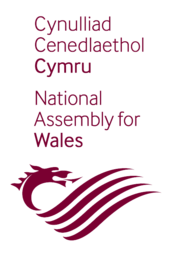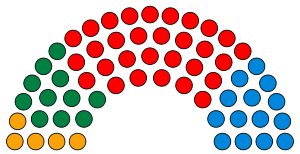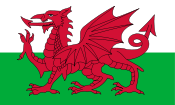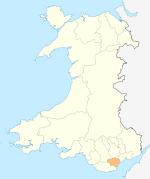- National Assembly for Wales
-
National Assembly for Wales
Cynulliad Cenedlaethol Cymru
Type Type Unicameral Leadership Presiding Officer Rosemary Butler AM, Labour
since 11 May 2011Leader of the House Jane Hutt AM, Labour
since 11 May 2011Structure Members 60 
Political groups Labour (30)
Conservative (14)
Plaid Cymru (11)
Liberal Democrat (5)Committees - Audit
- Business
- Equality of Opportunity
- Europe and External Affairs
- Finance
- Petitions
- Standards and Conduct
- Subordinate Legislation
- Scrutiny of the First Minister
- Communities and Culture
- Enterprise and Learning
- Health, Wellbeing and Local Government
- Sustainability
- LCO Legislative
Elections Last election 5 May 2011 Meeting place 
Senedd, Cardiff Website www.assemblywales.org The National Assembly for Wales (Welsh: Cynulliad Cenedlaethol Cymru) is a devolved assembly with power to make legislation in Wales. The Assembly comprises 60 members, who are known as Assembly Members, or AMs (Welsh: Aelod y Cynulliad). Members are elected for four-year terms under an additional members system, where 40 AMs represent geographical constituencies elected by the plurality system, and 20 AMs from five electoral regions using the d'Hondt method of proportional representation.
The Assembly was created by the Government of Wales Act 1998, which followed a referendum in 1997. On its creation, most of the powers of the Welsh Office and Secretary of State for Wales were transferred to it. The Assembly had no powers to initiate primary legislation until limited law-making powers were gained through the Government of Wales Act 2006. Its primary law-making powers were enhanced following a Yes vote in the referendum on 3 March 2011, making it possible for it to legislate without having to consult the UK parliament, nor the Secretary of State for Wales in the 20 areas that are devolved.[1]
Contents
History
Road to the Assembly
The establishment of the Welsh Office in 1964 effectively created the basis for the territorial governance of Wales.[2] The Royal Commission on the Constitution (the Kilbrandon Commission) was set up in 1969 by Harold Wilson's Labour Government to investigate the possibility of devolution for Scotland and Wales.[3] Its recommendations formed the basis of the 1974 White Paper Democracy and Devolution: proposals for Scotland and Wales,[3] which proposed the creation of a Welsh Assembly. However, voters rejected the proposals by a majority of four to one in a referendum held in 1979.[3][4]
Wales 
This article is part of the series:
Politics and government of
WalesNational AssemblyWales in the UKWales in the EUSubdivisons
After the 1997 general election, the new Labour Government argued that an Assembly would be more democratically accountable than the Welsh Office. For eleven years prior to 1997 Wales had been represented in the UK cabinet by a Secretary of State who did not represent a Welsh constituency at Westminster.[5] A second referendum was held on 18 September 1997 in which voters approved the creation of the National Assembly for Wales by a majority of 6,712 votes, or 50.3% of the vote.[6]
The following year the Government of Wales Act was passed by Parliament, establishing the Assembly.
In July 2002, the Welsh Government established an independent commission, with Lord Richard (former leader of the House of Lords) as chair, to review the powers and electoral arrangements of the National Assembly in order to ensure that it is able to operate in the best interests of the people of Wales.[7] The Richard Commission reported in March 2004. It recommended that the National Assembly should have powers to legislate in certain areas, whilst others would remain the preserve of Westminster.[7] It also recommended changing the electoral system to the single transferable vote (STV) which would produce greater proportionality.[7]
In response the UK Government, in its Better Governance for Wales White Paper, published on 15 June 2005, proposed a more permissive law-making system for the Welsh Assembly based on the use of Parliamentary Orders in Council.[8][9] In so doing, the Government rejected many of the cross party Richard Commission's recommendations. This has attracted criticism from opposition parties and others.
Recent polls suggest that a majority of the Welsh support full legislative powers.[10] Over 80% of people in Wales want a new parliament according to a new survey published in 2008 and Assembly members are willing to extend further powers to Cardiff Bay from Westminster.
Enhanced powers: The Government of Wales Act 2006
Main article: Government of Wales Act 2006The Government of Wales Act 2006 received Royal Assent on 25 July 2006. It confers on the Assembly legislative powers similar to other devolved legislatures through the ability to pass Assembly Measures concerning matters that are devolved. Requests for further legislative powers made through legislative competence requests are subject to the veto of the Secretary of State for Wales, House of Commons or House of Lords.
The Act reforms the assembly to a parliamentary-type structure, establishing the Welsh Government as an entity separate from, but accountable to the National Assembly. It enables the Assembly to legislate within its devolved fields.
The Act also reforms the Assembly's electoral system. It prevents individuals from standing as candidates in both constituency and regional seats. This aspect of the act was subject to a great deal of criticism, most notably from the Electoral Commission.
The Act has been heavily criticised. Plaid Cymru, the Official Opposition in the National Assembly from 1999–2007, attacked it for not delivering a fully-fledged Parliament. Many commentators have also criticised the Labour Party's allegedly partisan attempt to alter the electoral system. By preventing regional Assembly Members from standing in constituency seats the party has been accused of changing the rules to protect constituency representatives. Labour had 29 members in the Assembly at the time, all of whom held constituency seats.
The changes to the Assembly's powers were commenced on 4 May 2007, after the election.[11]
Buildings
Senedd
Main article: SeneddSee also: Senedd on televisionThe debating chamber in Cardiff Bay, the Senedd (English:Senate), was designed by the Richard Rogers Partnership and built by Taylor Woodrow, with environmental and MEP design by BDSP Partnership. It uses traditional Welsh materials such as slate and Welsh Oak in its construction, and the design is based around the concepts of openness and transparency. The Timber ceiling and centre funnel, manufactured and installed by BCL Timber Projects (sub-contracted by Taylor Woodrow) is made from Canadian sourced Western Red Cedar.
The Senedd houses the debating chamber (Welsh: Siambr) and Committee Rooms. It was officially opened by Queen Elizabeth II on St. David's Day, 1 March 2006.[12]
 The Senedd, home to the National Assembly for Wales
The Senedd, home to the National Assembly for Wales
The Senedd is designed to be environmentally friendly: it uses an Earth Heat Exchange system for heating; rainwater is collected from the roof and used for flushing toilets and cleaning windows, and the roof features a wind cowl which funnels natural light and air into the debating chamber below.[13]
Tŷ Hywel, Pierhead Building and Cathays Park Buildings
The debating chamber was initially based in Ty Hywel, next to the site of the present building. The offices of Assembly Members are still in this building which is connected to the Senedd by a skyway. The National Assembly for Wales Commission is also responsible for the Pierhead Building, which is the location of "The Assembly at the Pierhead" exhibition, and is the Visitor and Education Centre for the National Assembly for Wales as well as housing a small giftshop. The exhibition (currently still in the process of being updated following May's election) provides visitors with a unique opportunity to access the most up-to-date information on who's who, what's happening and how the Assembly works. Cathays Park consists of two buildings; the older building contains offices for the First Minister for Wales and senior civil servants, whilst the newer building is a large modern building built as an extension to the older building.
Elected officials
Main article: Presiding Officer of the National Assembly for WalesAfter each election, the Assembly elects one Assembly Member to serve as Presiding Officer (Welsh: Llywydd), and another to serve as a deputy. Rosemary Butler, Labour AM, has been Presiding Officer since the beginning of the 2011–2016 term, having taken over from Dafydd Elis Thomas. Lord Elis-Thomas, Plaid Cymru AM, had been Presiding Officer since the Assembly's creation, standing down from the post in 2011. Butler had been his deputy since 2007. The Presiding Officer also acts as Chair of the National Assembly for Wales Commission. Both the Presiding Officer and the Deputy Presiding Officer are expected not to vote.
Permanent officials
The permanent administrative and support staff of the Welsh Assembly are employed by the Assembly Commission They are not civil servants although they enjoy similar terms and conditions of service to members of the UK home civil service.
Powers and status
See also: Welsh devolution referendum, 2011The National Assembly consists of 60 elected members. They use the title Assembly Member (AM) or Aelod y Cynulliad (AC).[15] The executive arm of the National Assembly for Wales, the Welsh Government, has been a Labour administration led by First Minister, Carwyn Jones, since May 2011.[16] The previous administration (then known as the Welsh Assembly Government), had been a coalition between Labour—led by First Minister, Carwyn Jones—and Plaid Cymru—led by Deputy First Minister, Ieuan Wyn Jones — from December 2009 and to May 2011.[17][18]
The executive and civil servants are mainly based in Cardiff's Cathays Park while the Assembly Members, the Assembly Commission and Ministerial support staff are based in Cardiff Bay where a new £67 million Assembly Building, known as the Senedd, has recently been built.[19][20][21]
One important feature of the National Assembly until 2007 was that there was no legal or constitutional separation of the legislative and executive functions, since it was a single corporate entity. Compared with other parliamentary systems, and arrangements for devolution in other countries of the UK, this was unusual. In practice, however, there was separation of functions, and the terms "Assembly" and "Assembly Parliamentary Service" came into use to distinguish between the two arms. The Government of Wales Act 2006 regularised the separation when it came into effect following the 2007 Assembly Election.
Initially, the Assembly did not have primary legislative or fiscal powers, as these powers were reserved by Westminster. The Assembly did have powers to pass secondary legislation in devolved areas. Sometimes secondary legislation could be used to amend primary legislation, but the scope of this was very limited. for example, the first Government of Wales Act gave the Assembly power to amend primary legislation relating to the merger of certain public bodies. However, most secondary powers were conferred on the executive by primary legislation to give the executive (i.e., Ministers) more powers, and the Assembly has had wider legislative powers than appearances might suggest. For example, the Assembly delayed local elections due to be held in 2003 for a year by use of secondary powers, so that they would not correspond with Assembly elections. In 2001 the UK parliament used primary legislation to delay for one month local elections in England during the Foot and Mouth Disease epidemic.
The Assembly gained limited primary legislative powers following the 2007 election and the passage of the Government of Wales Act 2006. These laws are known as Assembly Measures and can be enacted in specific fields and matters within the legislative competency of the Assembly. New matters and fields can be devolved by Acts of the UK Parliament or by LCOs approved by Parliament.
While in principle the Assembly has no tax-varying powers, in reality it has some very limited power over taxes.[citation needed] For example, in Wales, as in England, the rate of Council Tax is set by local authorities, but since the Assembly largely determines the level of grants to local councils, it can influence the level of local taxation indirectly.[citation needed] It also has some discretion over charges for government services. Notable examples where this discretion has been used to create significant differences from other areas in the UK include:
- Charges for NHS prescriptions in Wales — these have now been abolished.[22]
- Charges for University Tuition — are different for Welsh resident students studying at Welsh Universities, compared with students from or studying elsewhere in the UK.[23]
- Charging for Residential Care — In Wales there is a flat rate of contribution towards the cost of nursing care, (roughly comparable to the highest level of English Contribution) for those who require residential care.[24]
This means in reality that there is a wider definition of "nursing care" than in England and therefore less dependence on means testing in Wales than in England, meaning that more people are entitled to higher levels of state assistance. These variations in the levels of charges may be viewed as de facto tax varying powers.
This model of more limited legislative powers was partly due to the fact that Wales has had the same legal system as England since 1536, when it was merged with England. Ireland and Scotland were never merged by England, and so always retained some distinct differences in their legal systems. The Scottish Parliament and the Northern Ireland Assembly both have deeper and wider powers.
The Assembly inherited the powers and budget of the Secretary of State for Wales and most of the functions of the Welsh Office. It has power to vary laws passed by Westminster using secondary legislation. Cheryl Gillan, who represents the English constituency of Chesham and Amersham, in the Westminster Parliament is currently the Secretary of State for Wales.
Following a referendum on 4 March 2011, the Welsh Assembly gained direct law making powers, without the need to consult Westminster.
Devolved areas
The National Assembly for Wales has the competence to pass bills for Acts of the Assembly in 20 "Subjects" outlined in schedule 7 of the Government of Wales Act 2006.[25]
Those subjects are:
- Agriculture, fisheries, forestry and rural development
- Ancient monuments and historic buildings
- Culture
- Economic development
- Education and training
- Environment
- Fire and rescue services and promotion of fire safety
- Food
- Health and health services
- Highways and transport
- Housing
- Local government
- Public administration
- Social welfare
- Sport and recreation
- Tourism
- Town and country planning
- Water and flood defence
- Welsh language
Members, constituencies, and electoral system
Under mixed member proportional representation, a type of additional member system,[26][27] forty of the AMs are elected from single-member constituencies on a plurality voting system (or first past the post) basis, the constituencies being equivalent to those used for the House of Commons and twenty AMs are elected from regional closed lists using an alternative party vote.[28] There are five regions: Mid and West Wales, North Wales, South Wales Central, South Wales East and South Wales West (these are the same as the pre 1999 European Parliament constituencies for Wales), each of which returns four members.[28] The additional members produce a degree of proportionality within each region.[28] Whereas voters can choose any regional party list irrespective of their party vote in the constituency election, list AMs are not elected independently of the constituency element; rather, elected constituency AMs are deemed to be pre-elected list representatives for the purposes of calculating remainders in the d'Hondt method.[28] Overall proportionality is limited by the low proportion of list members (33% of the Assembly compared with 43% in the Scottish Parliament and 50% in the German Bundestag) and the regionalisation of the list element.[29] Consequently, the Assembly as a whole has a greater degree of proportionality (based on proportions in the list elections) than the plurality voting system used for UK parliamentary elections, but still deviates somewhat from proportionality.[29] The Single Transferable Vote system had been considered for the Assembly by the Labour Party as early as 1995-96, but according to the evidence given to the Richard Commission by Ron Davies, a former Welsh Secretary,
“ Had we done that of course we would have had to have had a Boundary Commission and that process would have taken forever and a day and that would have frustrated our overall political timetable. So we had to settle on the existing constituency arrangements, parliamentary constituencies and European Constituencies.[29] ” To date there have been four elections to the Assembly, in 1999, 2003, 2007 and 2011.
Elections
There have been four elections to the Assembly, in 1999, 2003, 2007, and 2011.
Welsh Assembly election, 2011 Parties Constituency
(First past the post)Regional
(Additional member system)Total seats Votes % +/− Seats +/− Votes % +/− Seats +/− Total +/− % Labour 401,677 42.3 +10.1 28 +4 349,935 36.9 +7.2 2 ±0 30 +4 50.0 Conservative 237,388 25 +2.6 6 +1 213,773 22.5 +1.1 8 +1 14 +2 23.3 Plaid Cymru 182,907 19.3 –3.1 5 –2 169,799 17.9 –3.1 6 –2 11 –4 18.3 Liberal Democrats 100,259 10.6 –4.2 1 –2 76,349 8.0 −3.7 4 +1 5 –1 8.3 UKIP N/A N/A N/A 0 0 43,756 4.6 +0.7 0 0 0 0 0.0 Green 1,514 0.2 N/A 0 0 32,649 3.4 ±0.0 0 0 0 0 0.0 Socialist Labour N/A N/A N/A 0 0 23,020 2.4 +1.2 0 0 0 0 0.0 BNP 7,056 0.7 N/A 0 0 22,610 2.4 –1.9 0 0 0 0 0.0 Welsh Christian N/A N/A N/A 0 0 8,947 0.9 ±0.0 0 0 0 0 0.0 Communist N/A N/A N/A 0 0 2,676 0.3 –0.1 0 0 0 0 0.0 English Democrats 744 0.1 –0.1 0 0 1,904 0.2 ±0.0 0 0 0 0 0.0 Trade Unionists and Socialists Against Cuts N/A N/A N/A 0 0 1,639 0.2 N/A 0 0 0 0 0.0 Monster Raving Loony N/A N/A N/A 0 0 1,237 0.1 N/A 0 0 0 0 0.0 Independent 12,478 1.3 –1.7 0 –1 1,094 0.1 –0.9 0 0 0 –1 0.0 Llais Gwynedd 3,225 0.3 N/A 0 0 N/A N/A N/A 0 0 0 0 0.0 Putting Llanelli First 2,004 0.2 N/A 0 0 N/A N/A N/A 0 0 0 0 0.0 Total 949,252 40 949,388 20 60 Composition
Affiliation Members Welsh Labour Party 30 Welsh Conservative Party 14 Plaid Cymru 11 Welsh Liberal Democrats 5 Labour Minority 0 Following the 2011 election, Welsh Labour held exactly half of the seats in the Assembly, falling just short of an overall majority. This meant that only Labour can form a government.[30] On 17 May, it was noticed that two members (Aled Roberts and John Dixon) elected for the Liberal Democrats held posts which disqualified them from being Assembly members.[31] After investigation it emerged that Aled Roberts had received the wrong information from the Electoral Commission, and was re-admitted to the National Assembly after a vote by AMs. The Liberal Democrats withdrew a request to re-admit the other AM, John Dixon, who has been replaced by Eluned Parrott, who was second in the South Wales Central Region.[32]
See also
- Contemporary Welsh Law (Assembly Acts)
- List of Welsh Assembly by-elections
- London Assembly
- Members of the National Assembly for Wales
- National Assembly for Wales constituencies and electoral regions
- National Assembly for Wales election, 1999
- National Assembly for Wales election, 2003
- National Assembly for Wales election, 2007
- National Assembly for Wales election, 2011
- Northern Ireland Assembly
- Scottish Parliament
- Parliament of the United Kingdom
- United Kingdom budget
References
- ^ "Wales says Yes in referendum vote". BBC News. 4 March 2011. http://www.bbc.co.uk/news/uk-wales-politics-12648649.
- ^ The road to the Welsh Assembly from BBC Wales History website. Retrieved 23 August 2006.
- ^ a b c Devolution in the UK: Department for Constitutional Affairs. UK State website. Retrieved 9 July 2005.
- ^ The 1979 Referendums: BBC website. Retrieved 9 July 2006.
- ^ Evidence to Richards Commission of Cllr Russell Goodway. 10 July 2003. Retrieved 9 July 2006.
- ^ Politics 97 by Joshua Rozenberg: BBC website. Retrieved 9 July 2006.
- ^ a b c The Richard Commission. Richard Commission Website, includes copy of Commission report. Retrieved 9 December 2005.
- ^ Better Governance for Wales White Paper. Presented to Parliament by the Secretary of State for Wales in June 2005. Downloadable PDF. Retrieved 9 December 2005.
- ^ Electoral Reform for Wales. Electoral Reform Society response to rejection of Richard Commission recommendations. Retrieved 9 December 2005.
- ^ Wales 'is warming to devolution'. BBC News, 3 May 2007. Accessed 10 May 2007.
- ^ Assembly powers bill becomes law: BBC News. 25 July 2006. Retrieved 15 September 2006.
- ^ The New National Assembly for Wales Senedd opened on St David’s Day National Assembly for Wales, Public Information page. Retrieved 4 May 2006
- ^ "National Assembly for Wales - the Senedd, Cardiff Bay, docks and Tiger Bay, Cardiff, south Wales". Urban75.org. http://www.urban75.org/photos/wales/welsh-assembly-senedd.html. Retrieved 21 May 2011.
- ^ "''BBC NEWS'' | Wales | Wales politics | First Welsh law's royal approval". BBC News. 9 July 2008. http://news.bbc.co.uk/1/hi/wales/wales_politics/7497491.stm. Retrieved 21 May 2011.
- ^ The National Assembly for Wales, Civil rights — In Wales, Advice guide, Citizens Advice Bureau. Retrieved 13 July 2006.
- ^ "Carwyn Jones unveils three new faces in Welsh cabinet". BBC News website (BBC). 13 May 2011. http://www.bbc.co.uk/news/uk-wales-politics-13389400. Retrieved 14 May 2011.
- ^ "Welsh Assembly Government - Cabinet Members". Welsh Assembly Government website. Welsh Assembly Government. 2007. http://wales.gov.uk/about/cabinet/cabinetm/?lang=en. Retrieved 16 April 2009.
- ^ "WalesOnline - News - Politics - Politics News - Crucial extracts from the One W". Martin Shipton, Western Mail. WalesOnline. 28 June 2007. http://www.walesonline.co.uk/news/welsh-politics/welsh-politics-news/tm_headline=crucial-extracts-from-the-one-wales-labour-plaid-cymru-coalition-document&method=full&objectid=19367181&siteid=50082-name_page.html. Retrieved 16 April 2009.
- ^ National Assembly for Wales and Welsh Assembly in Guide to government: Devolved and local government, Direct.gov.uk, UK state website. Retrieved 13 July 2006.
- ^ Assembly Building: Welsh Assembly website. Retrieved 13 July 2006.
- ^ New assembly building opens doors: BBC News, 1 March 2006. Retrieved 13 July 2006.
- ^ Q and A: Welsh prescription prices: BBC News, 1 October 2004. Retrieved 31 July 2006.
- ^ Q&A: Welsh top-up fees: BBC News, 22 June 2005. Retrieved 31 July 2006.
- ^ "NHS Continuing Care - Commons Health Select Committee", News and Views - NHFA. Retrieved 10 November 2006.
- ^ "Government of Wales Act 2006". Legislation.gov.uk. http://www.legislation.gov.uk/ukpga/2006/32/schedule/7. Retrieved 21 May 2011.
- ^ Mixed-Member Proportional Voting in Proportional representation voting systems, Types of Voting Systems: PR Library created by Professor Douglas J. Amy, Department of Politics, Mount Holyoke College. Retrieved 8 July 2006.
- ^ Electing the Welsh Assembly: Electoral Reform Society, information regarding Additional member system elections. Retrieved 9 December 2005.
- ^ a b c d The Welsh electoral system: BBC News, 7 June 1999. Retrieved 7 July 2006.
- ^ a b c Chapter 12: The Electoral Arrangements of the Report of the Richard Commission: Commission on the Powers and Electoral Arrangements of the National Assembly for Wales.. PDF document. Retrieved 8 July 2006.
- ^ Betsan Powys (7 May 2011). "BBC News - Vote 2011: Labour to dictate terms of government deal". Bbc.co.uk. http://www.bbc.co.uk/news/uk-wales-politics-13315241. Retrieved 21 May 2011.
- ^ Withers, Matt (19 May 2011). "Two new AMs remain disqualified". Western Mail. http://www.walesonline.co.uk/news/welsh-politics/welsh-politics-news/2011/05/19/two-new-ams-remain-disqualified-91466-28721644/.
- ^ http://www.bbc.co.uk/news/uk-wales-14048630
External links
- National Assembly for Wales (Assembly website)
- WalesCymru: Assembly
- Welsh politicians, including those of Welsh descent in other countries
- Assembly website in Welsh/Gwefan y Cynulliad yn Gymraeg
- NAW: Constituencies and Electoral Regions (map of the constituencies showing current members)
- NAW: Who? - Elected Members (list of members by constituency)
- Government of Wales Act 1998
- Government of Wales Act 2006
- Government of Wales Act 2006 website
- BBC's Senedd guide
- National Assembly for Wales - Video
Categories:- Politics of Wales
- National Assembly for Wales
- Parliaments by country
- National legislatures
- Politics of Cardiff
- Unicameral legislatures
Wikimedia Foundation. 2010.


